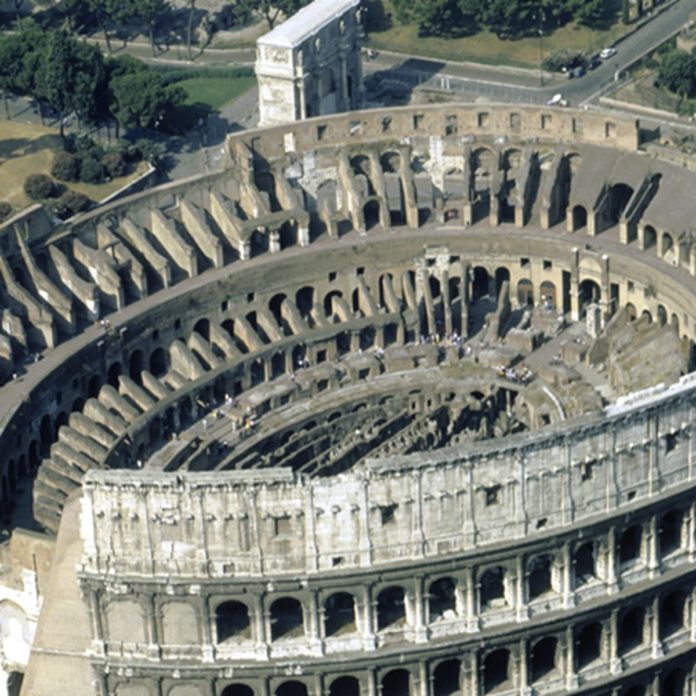“Power to the people, by the people and of the people”- this has always been the founding creed of Democracy and the magnanimous Roman Empire believed no different. It was not surprising that an emperor had built a golden palace just for himself shunning public emotions, while his successors reverted back to the wisdom of “ give the people what they want” and thus commissioned one of the greatest architectural wonders of the world,- the Roman Colosseum.
The founding stone of the Colosseum was laid sometime between A.D 70 and 72 by Emperor Vespasian. Originally christened as “The Flavian Amphitheatre”, It was thrown open to the public shows almost a decade later under the rule of Emperor Titus. The Colosseum on its completion was a massive and imposing structure rising up to 57 meters in height while it measured 188 meters in length and 156 meters in breadth. The sheer bulk of the structure is enough to take one’s breath away even today for tourists who visit it all year-round.
The Colosseum was a place of entertainment for the common mob, beginning from fights of exotic animals to executions of prisoners and gladiatorial fights. Even naval battles had been organized for some time. However, since the 6th century, the Colosseum has suffered from disgrace. It has been the site for lootings, bombings and has been damaged quite a number of times by earthquakes. However, it still stands tall as a supreme symbol of the fusion of human architecture and intellect.
The most astonishing part of the Colosseum is the hypogeum, the part that remained under the main arena. It was here that all the mechanizations took place which was crucial for the “show” above. It was here that gigantic levers, pulleys, trapdoors were used by slaves and other subalterns to arrange for various deus ex machina for the spectators above. From grandiose scenery to caged animals and sudden and dramatic entrances, all were raised and controlled from the hypogeum below. It was reported that those who worked at the lower base, i.e. the hypogeum, were also sometimes forcefully raised onto the Colosseum and forced to fight unto death on account of negligence in the discharge of duties. Over the years
Researchers have figured out the holes and buttresses made for the movement of the levers and even the mechanism to let in water into the Colosseum for mock naval battles. The water was channeled from a nearby stream.
The gallery of the Colosseum was something spectacular. With a capacity of over 50.000 citizens, it was and still remains a wonder of both the ancient and the modern world. The architecture also boasted several notable engineering features. One such feature would be the vela ( “sails” in Latin) The vela were awnings made of canvas or similar material that covered the audience, from the scorching heat if the Sun. However, the Romans ever conscious of their social hierarchies and other social institutions had separate arrangements made for the elite and the common. There were exclusive corridor systems for people belonging to separate social rungs.
Needless to say, that the structure is the witness as well as an active participant in the historical evolution of Man and his society. If viewed as an organic whole, the structure of the Colosseum was given its final shape through the hands of three generations of Roman emperors and as it grew, it also “evolved”. New galleries were added to it thus increasing it height, the carefully and tricky hypogeum was given shape along with all the tricks and shadows it would employ to provide the ultimate satisfaction to the human mind for the bloody scenes. Evolving through the ages, the Colosseum has demonstrated extreme resilience and has earned its mettle for its survival instinct. history has it, that in the 16th century, Pope Sixtus V, tried to convert it to a wool factory, with workshops on the arena floor and living quarters in the upper stories. However, as fate would have it the structure survived the ordeal due to the huge cost estimation that was made
The “satisfaction” of the common mob was a psychological instrument to keep their minds busy and what could be grander than the fact that the emperor in all his grandiosity was himself present to watch the games. For the emperor and the rule, this was not merely entertainment it was a necessity to maintain the rule of law that the Roman republic took pride in.
It is bewildering to imagine, the structure has been struck by more natural elements than human wrath and still stands tall. Its construction being unique, as most amphitheaters of its time were built on the side of mountains for natural support however the Roman Colosseum, is one of its kind as it stands in the middle supported only by its own arches, requiring no natural support and yet over the years has withstood the ravages of time.
When one visits this architectural wonder, touching the sides of the stones, each of which has a unique tale to tell and witnessing the enormity, immensity of the structure, one can only sit down on the steps and feel oneself together with this organic historical enigma. As the Sun travels westward, one feels the breath of history speaking to one’s ears. and as dusk closes in and darkness looms ahead, the Colosseum stands as a monument of Human Pride and magnanimity, calling out the world, for edification from History and to make this world a wonderful place for human inhabitance.
If only we could hear and heed the call, would we?
By Abhishek Aich











